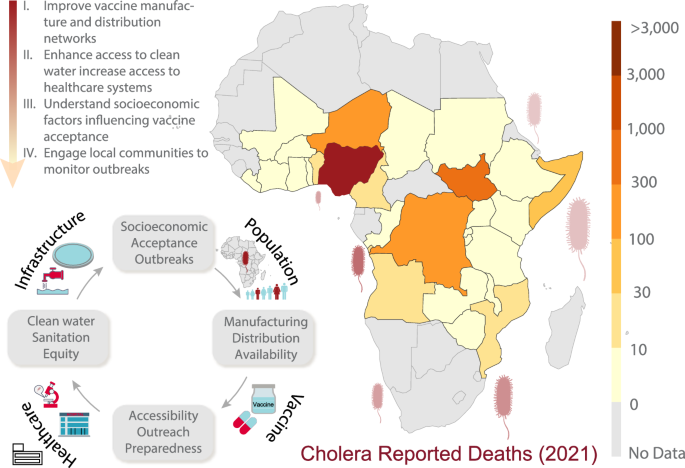The Global Task Force on Cholera Control has set goals to cut cholera mortality by 90% and eradicate cholera in up to 20 countries by 2030. These targets necessitate investments in safe water and sanitation infrastructure for all. Capacity must also be built for preventative, readiness, and preparedness operations, such as simplifying the supply chain for critical diagnostics. Vaccine manufacturing must be increased globally and in severely afflicted areas, including many regions in Africa. Even though Ghana has demonstrated that it is possible to decentralize and increase sustainable vaccine production in Africa, becoming the continent’s first manufacturer of a cholera vaccine13, the continent provides less than 1% of the vaccines it uses.
While vaccine production is important in reducing the spread of cholera, the lack of basic water infrastructure to produce safe and clean drinking water and the continued struggle to achieve basic hygiene services make any progress toward vaccine development rather irrelevant. In 2022, UNICEF reported that a 12-fold increase in current rates of progress on safely managed drinking water, a 20-fold increase for safely managed sanitation, and a 42-fold increase for basic hygiene services are needed to achieve the Sustainable Development Goal targets in Africa14. Therefore, substantial investments are needed to provide clean water, basic sanitation, and hygiene. While water governance and management are key considerations, developing basic water infrastructure is a prerequisite to ensure accessibility to clean drinking water.
Partnerships and capital investment are urgently required throughout African countries to tackle vaccination and clean water shortages. Integrating vaccine distribution with water infrastructure development is critical for cholera prevention. Priority should be given to analyzing and correcting water infrastructure inadequacies in areas with high cholera rates and inadequate vaccination access. It is critical to establish community-run water purification centers that can also serve as vaccination locations. Climate change and population expansion must be taken into account while addressing water constraints. Agreements that encourage water diplomacy and resource sharing across the continent are critical. Furthermore, it is vital to take care of the entire water supply chain, from source to consumption for effective management including frequent quality assessments of water sources. Water must be transported in clean, covered containers to avoid exposure to pollutants, stored in sanitized containers at home and, ideally, treated before use to eradicate microorganisms, such as boiling or chlorinating. It is also critical to educate populations about the dangers of unclean drinking water and good hygiene procedures. Regular community participation and hygiene promotion can greatly raise awareness and adherence to clean water practices, lowering the risk of cholera and other waterborne illnesses.
Improving access to medical services and vaccine delivery, particularly in remote regions, as well as expanding vaccine networks, can help patients receive treatments and vaccines promptly. Mapping healthcare and water access against disease data can help identify important needs and predict the impact of climate change and conflicts. Improving logistics by boosting storage at vaccine sites and introducing mobile units with water purification while lowering their exposure to natural and man-made hazards is critical. Integrating Cholera vaccinations into health systems, as well as enhancing outreach and collaborations, can help to increase vaccine uptake and disease monitoring. Health systems in high-risk areas should create emergency plans to deal with anticipated patient surges. Finally, effective epidemic control and the protection of vulnerable populations require close collaboration among nongovernmental organizations (NGOs), local authorities, communities, governments, and professionals (Fig. 1).
Illustration of the required coordinated efforts to increase vaccine distribution and improve physical infrastructure to reduce cholera outbreaks, along with data showing reported deaths from cholera outbreaks across Africa in 2021 (Data Source: Outworld in Data15).


